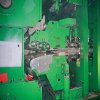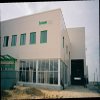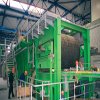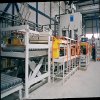Big plans for a big site
5 January 2004It is September 17, 2002 and the priest of Egorievsk is formally consecrating the ground on which the newly formed company OOO Kronospan will build the first phase of its panel manufacturing and processing complex.
Fourteen months later, in November 2003, the first continuous MDF line in Russia has started production.
This was a true ‘greenfield’ project, since all the company had on day one was a very large expanse of ground and a rented office across the road. The ground concerned totals a staggering 140ha of virtually flat terrain mainly surrounded by trees, on the outskirts of this small town which forms part of the Moscow District.
From Egorievsk it is 120km to the capital and only four kilometres to the fourth and outermost of the ring roads which encircle this historic city.
So why did Peter Kaindl, owner of OOO Kronospan and a good number of other panel making factories worldwide, choose Russia for his latest investment? And why Egorievsk?
Markus Habegger, managing director of Egorievsk and several other eastern European factories belonging to the Kaindl group, explains that Russia is a very big country and a very big market.
It also has very little in the way of quality MDF production and virtually nothing in the production of laminate flooring – a prime target sector for the Egorievsk facility.
Russia is, even after the collapse of communism, a very ‘centralistic’ economy with Moscow at its centre. Nobody speaks of ‘Egorievsk’, but of ‘Moscow’, and the Moscow District (with a radius of about 150km) boasts a population of around 20 million people. Those people are perceived to be generally well-educated and to have a steadily increasing spending power.
Road and rail connections between Egorievsk and Moscow are good and gas and electricity supplies are also reliable and available close to the factory site.
Add to that the fact that the Moscow District has the highest concentration of furniture manufacturers in Russia, who are all looking for a good quality supplier of MDF, and you have all your reasons, except one, for building here.
That last reason is one that is common to much of Russia – the raw material resource, which is vast.
There are cheaper places in Russia to develop a new factory and the wood raw material would be cheaper too. Such as Siberia. However, the infrastructure is not as good, the distance to market is too great and, while English and German are quite commonly spoken in Moscow, foreign languages are something of a rarity in more remote areas.
Phase one of the development of the Egorievsk complex consists of several parts. The core is a continuous MDF production line with a design capacity of up to 280,000m3 a year (depending on product specification). At its heart is a Siempelkamp ContiRoll press, 28m long and 2.5m wide.
There is also a brand new laminate flooring production line with a capacity of over 12 million m2 a year, based on the latest generation Hymmen Isopress. This 1.04m wide continuous laminating press is backed up by the latest generation Kronospandesigned and built handling equipment, as used in the company’s factory at Lungötz in Austria. The Hymmen press is equipped with both smooth and engraved continuous stainless steel belts.
Further value-adding capacity is provided by a brand new Wemhöner short-cycle press line. This is intended to offer oneand two-side lamination for mouldings manufacturers, and furniture makers, respectively.
The third part of phase one comprises a wall/ceiling panel manufacturing line with foil lamination.
At the time of my visit in October, a full range of MDF making and value-adding facilities was scheduled to come on stream at the end of November this year, as phase one of the development, also known at the company as the ‘start-up package’.
Kronospan is not a company that buys turnkey packages from anybody for its production lines. It has been in the business long enough, and made enough highly successful new investments, to know exactly what it wants and how to make it. Thus all the value-adding facilities at Egorievsk were built up from a mixture of bought-in machinery, with the flooring line alone having equipment from 20 different suppliers, as well as from Kronospan’s own machinery factory at Presov in Slovakia.
The second part of phase one at Egorievsk is already under way, with the order placed for a brand new calendar (Mende-type) MDF line to make thicknesses up to 9mm, mainly for wall panelling. Start-up of this second line is planned for the third quarter of 2004 and that will bring total raw MDF capacity at the site up to 400,000m3 per year. A lacquering line is also planned.
Finally, for phase one, a resin plant is scheduled to go into production in Spring 2005 with a capacity of about 80,000 tonnes per annum and at a cost of about 200m. This makes total investment at Egorievsk about 500m, according to Kronospan.
“In Russia we are the first in MDF flooring and value-added products as well as being the first with a continuous MDF production line and a continuous flooring line,says Mr Habegger.
The final decision to invest in Egorievsk was made in early 2002 with the signing of an investment agreement with the government of the Moscow Region, and the OOO Kronospan company was founded in April of that year.
Sales and marketing activity, based in that rented office, commenced immediately, with products mainly being delivered from Kronospan’s MDF mill in Mielec, Poland. This added to Kronospan’s 10 years of experience in exporting MDF to Russia.
Groundwork at Egorievsk began immediately after the consecration in September 2002.
The woodyard has a plentiful supply of fresh logs, mainly pine and spruce (there are no sawmills in this area to supply residues). The yard is fully concreted to keep the raw material clean and the factory has its own concrete batching plant and this will be kept on and used in the future development of the site.
The logs are conveyed up and over the railway branch line, which comes onto the site from the Egorievsk-Moscow main line, and onto the debarker, then to the hogger line, made up with machinery from a number of suppliers.
Chips go to one of two large cylindrical concrete silos and thence to the top of the refiner building.
An Andritz 46in refiner serves line 1 and a second refiner will be added to feed MDF line 2. The glue kitchen and glue distribution system was supplied by Imal of Italy.
This first MDF line was built up from a number of sources. The basis of it was a secondhand Siempelkamp continuous press of 1996 manufacture from the former Etz Lavud factory in Israel. However, this line was heavily revamped and the pressgiven a much higher capacity, partly by being extended from 18m to 28m, but also by being upgraded with new heating platens and the very latest flexible press entry.
So it is, to all intents and purposes, a new press to the latest Siempelkamp specifications – with additional Kronospan input, of course. There are two star coolers at the end of the line.
Panels are transported by railed transfer truck to the adjacent hall where valueadding takes place.
A Steinemann eight-head sander with conventional metal frame prepares the surfaces of the boards which can then proceed to either the Hymmen or the Wemhöner line for surfacing.
Impregnated paper is currently bought in, but plans are in hand for a possible impregnation line in the future and the space is certainly available for one.
Transfer from the Hymmen press line to the Homag ISE profiling line for laminate flooring is fully automatic by railed transfer truck.
There is a wrapping, packing and strapping line for the laminate flooring.
A large floor space between the flooring line and the Wemhöner line at the time of my visit in early October is now filled with the new wall panelling line, completing the value-adding facilities at Egorievsk – at least for now.
The space beside the ContiRoll line will be filled by the calender press of the second MDF line in due course. This will, of course, be a much shorter line than the ContiRoll.
There is a large warehouse, again fed automatically by railed transfer truck, which will accommodate all Kronospan group products from this factory and others as a ‘one-stop-shop’ facility.
A railway spur also comes into the warehouse so the factory is connected directly with the Moscow-Egorievsk line, both for incoming raw materials and outgoing finished products. Road transport is also used.
An energy plant serves the whole site and will accommodate the needs of the future planned expansions to production. The moving grate furnace runs on gas, wood and dust, or oil, either separately or mixed. The boiler is by Loos International.
There are particular challenges for an energy system in this part of Europe, with temperatures falling as low as -400C in winter and rising to +400C in summer.
This also accounts for the secondary heating room for the thermal oil for the ContiRoll in case the temperature needs topping up in winter.
For electricity supply, while adequate voltage is available from the local grid, a transformer station has been built on site to supply a constant regulated supply of the correct voltage to the factory.
Airborne and waterborne emissions are controlled to normal European standards.
As Mr Habegger pointed out, there are big advantages to building a large factory such as this on a greenfield site; the layout of the line is dictated only by the ideal plan for efficiency in production and not by existing buildings and services.
On the downside, there is massive infrastructure work to be carried out including, in this case, the burying of all services at least 2.2m beneath the surface of the ground because of freezing winter temperatures.
Some piling was required on what is largely sandy ground, particularly for heavy items such as the presses.
The office space for OOO Kronospan is extensive in a light and airy building on the site, which incorporates a large showroom for value-added products.
Samples of laminate flooring, mouldings, postformed worktops, wall panelling and all the accessories for flooring and wall panels are exhibited on purpose-built display modules. The showroom itself also has a laminate floor.
Everything at Egorievsk is designed and built with the future in mind. And that future contains a lot of expansion plans to make use of what will ultimately be a 180-200ha freehold site.
Kronospan sees a very big future for it. The current ‘start-up’ package is enough for the company to be getting on with for now, but it has “big ideas for the future”. These include a full range of boards – particleboard, OSB and MDF, as well as resin production. There is plenty of room for them.
Ernst Kaindl also has another factory in Russia at Scharija, north east of Moscow, which he took over from a former wood materials combine. That factory currently produces wet-process fibreboard, but has ordered a 48.7m x 9ft Siempelkamp ContiRoll continuous press for the production of MDF/HDF. That line is due to start up in Spring 2004. As at Egorievsk, the Scharija factory is intended to develop into a one-stop-shop producer of all panel types and value-added products.
It is precisely the size of the Kronospan group’s operations which is part of the secret of its success. The group has built up a wealth of knowledge from its many plant start-ups and it is now in a position to do for itself much of what its competitors have to sub-contract out. That includes building machinery such as conveying and handling systems and many other components.
It is also building the press for the second MDF line at Egorievsk utilising its own resources. The entire calender press will be built up from components by Kronospan’s factory in the Czech Republic and at its workshops in Sczecinek.
“We are connected to all Kronospan engineering departments online and share the knowledge and experience of our staff,says Mr Habegger. “We have eight or 10 nationalities on this site from the group and we network with the rest of the group, online, on hand-phones, and so on.”
The company sees the furniture industry in Moscow as key to the development of Egorievsk and hopes its new factory will act “like a magnetin attracting new furnituremaking capacity to the region, driven by the shortage of volume producers of quality MDF and particle board. It is possible that western furniture manufacturers will also see opportunities for production in the region.
The Kronospan policy, in common with most of its European competitors, is quite clear in terms of how far it will go downstream. “We have no plans to make components or to compete with our customers,”says Mr Habegger.
When it comes to meeting demand for panel products up to that point, though, it is clear there are no discernible limits to the expansion of the company’s operations in Egorievsk – and possibly elsewhere in Russia.



